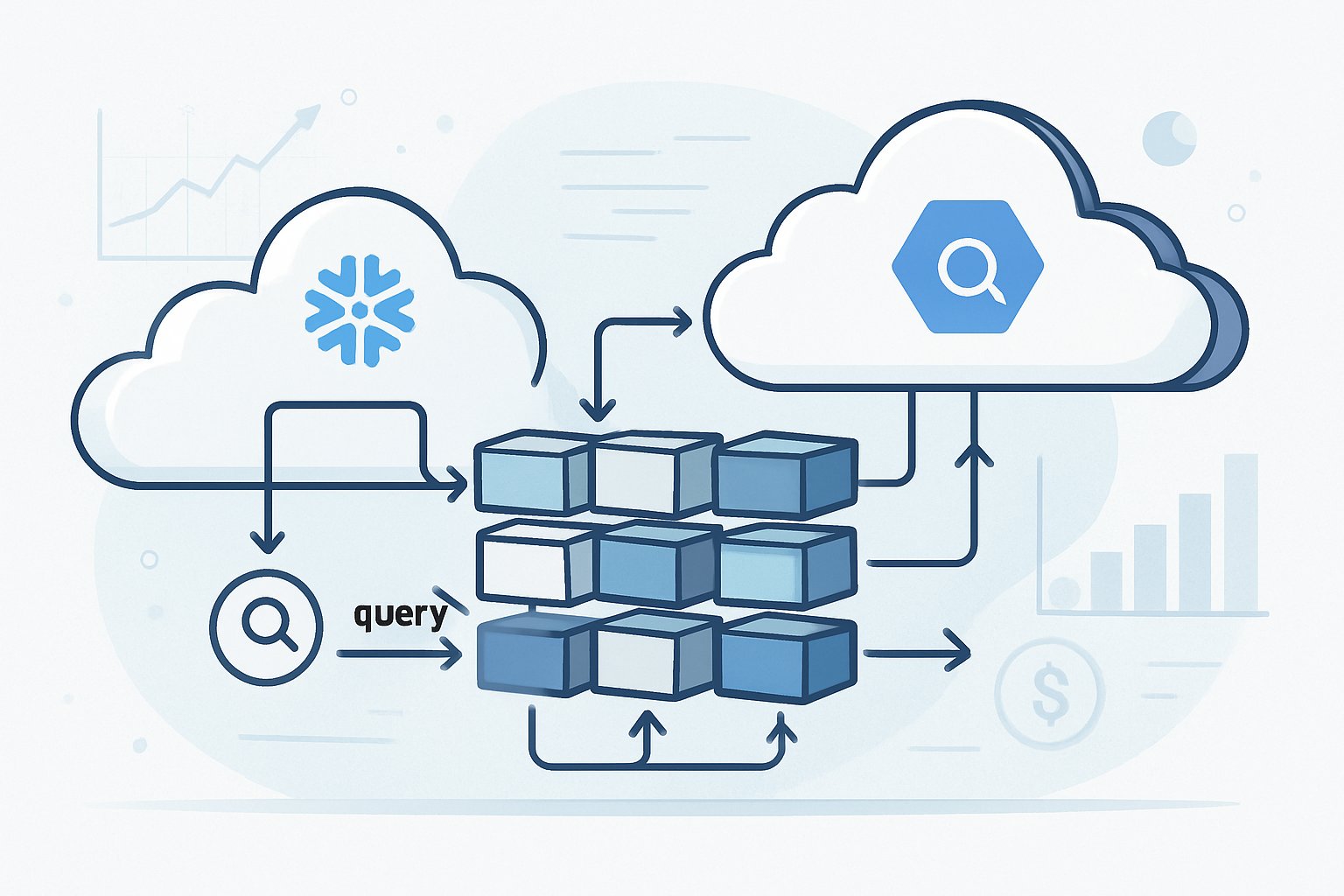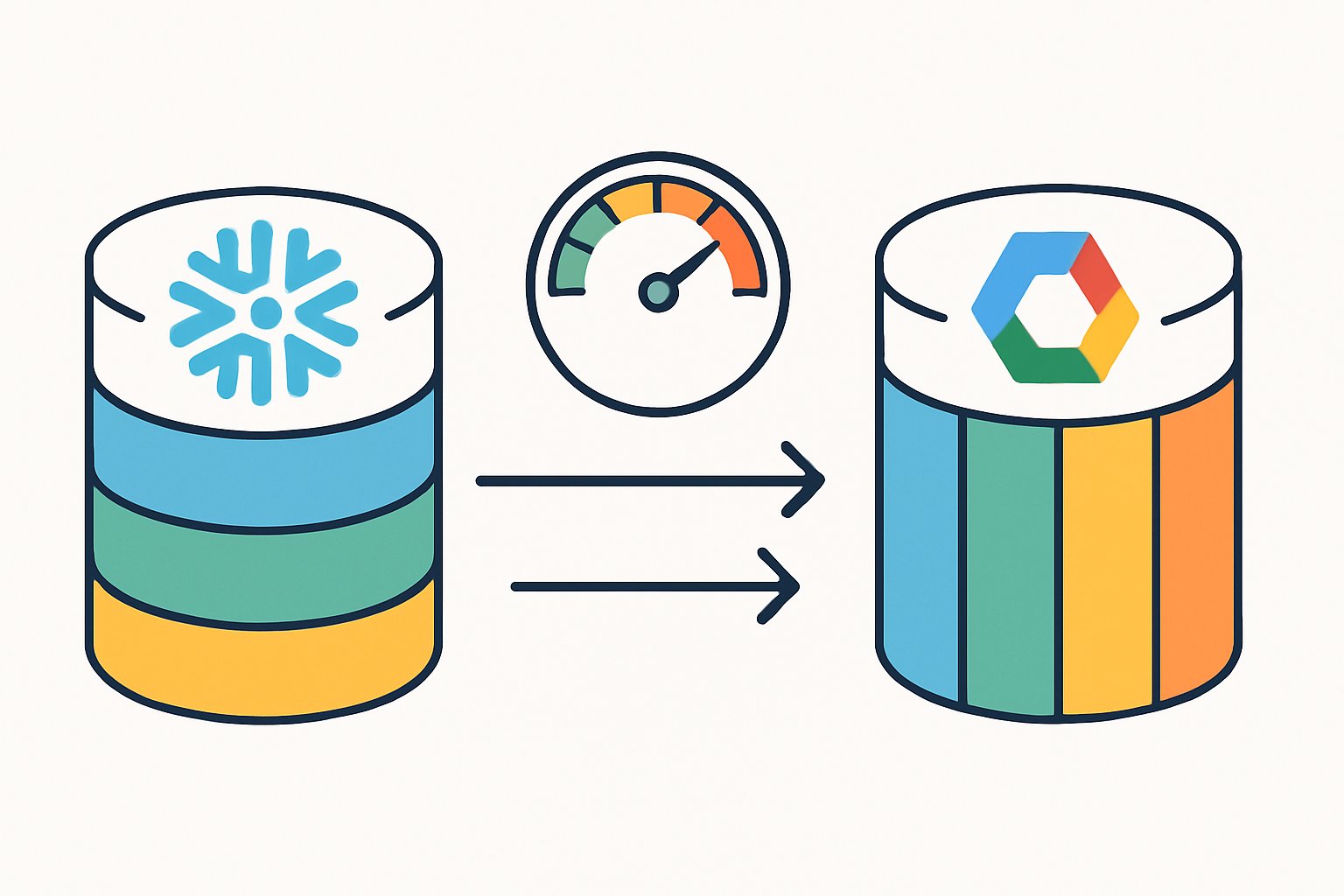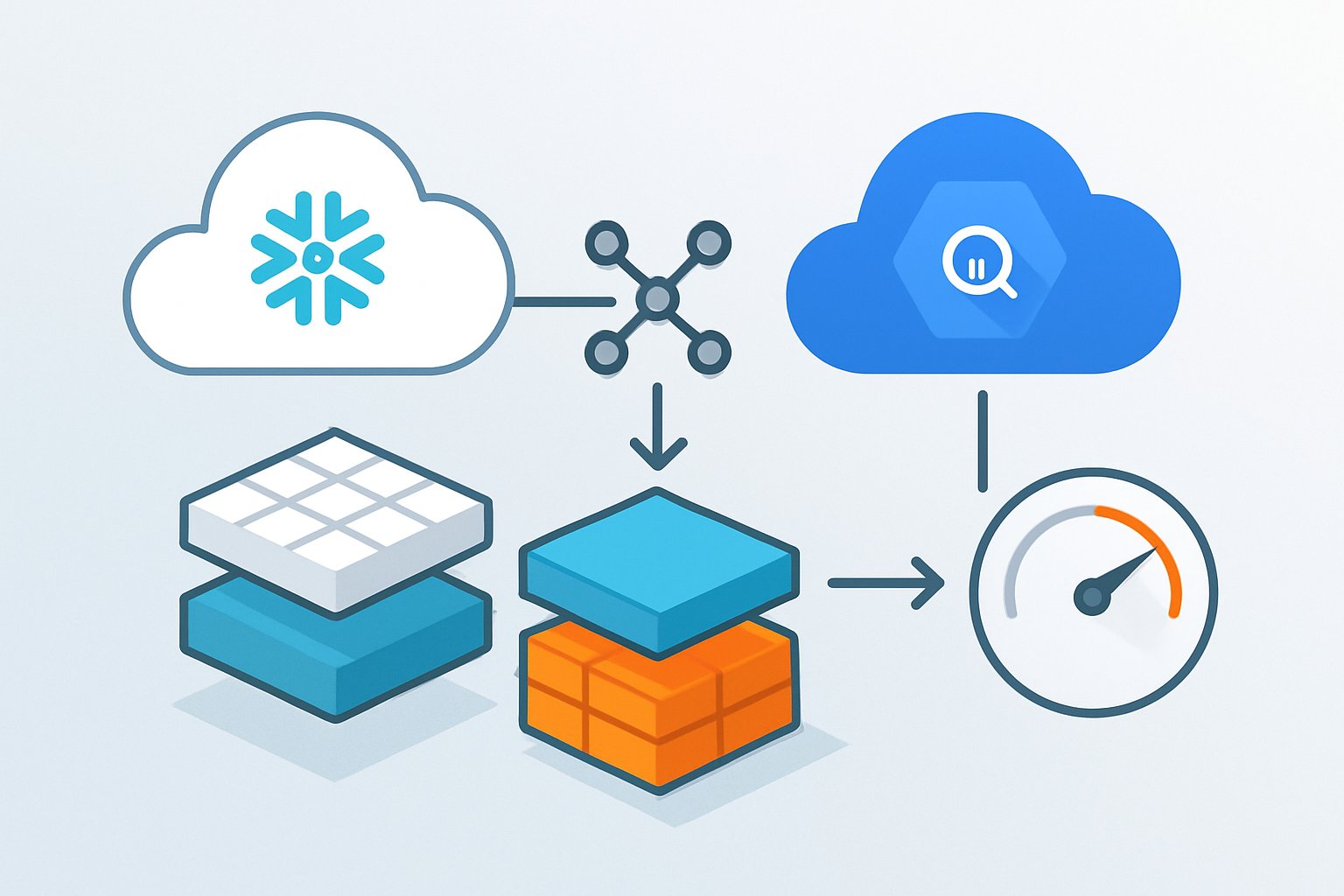Cloud data warehouses like BigQuery and Snowflake can quickly become expensive when queries scan entire datasets. Proper partitioning strategies can reduce query costs by up to 40% while dramatically improving performance by limiting the amount of data scanned during query execution. Both platforms offer powerful partitioning features, but each requires different approaches to achieve optimal cost control.

The key to effective partitioning lies in understanding how data flows through queries and selecting the right partition columns based on common filter patterns. BigQuery uses partitioned tables to divide large datasets into manageable segments, while Snowflake leverages micro-partitions and clustering to automatically organize data for efficient querying.
This guide explores proven partitioning strategies for both platforms, covering everything from basic time-based partitioning to advanced clustering techniques. Readers will learn how to choose effective partition columns, optimize query patterns, and implement best practices that deliver measurable cost savings and performance improvements.
Key Takeaways
- Time-based partitioning reduces costs by limiting data scanned when queries filter by date ranges
- BigQuery and Snowflake use different partitioning approaches that require platform-specific optimization strategies
- Choosing partition columns based on common query filter patterns maximizes cost control effectiveness
Understanding Partitioning for Cost Control

Partitioned tables divide large datasets into smaller, manageable segments that significantly reduce the amount of data scanned during queries. This approach directly controls query costs by limiting processing to relevant partitions while improving overall query performance through faster data retrieval.
Fundamental Concepts of Partitioned Tables
Partitioned tables organize data into distinct segments based on specific column values. Each partition contains a subset of the total dataset, typically organized by common query patterns like date ranges or geographic regions.
Snowflake’s Micro-Partitioning Approach:
- Automatically divides data into micro-partitions containing 50-500 MB of uncompressed data
- Creates partitions based on data insertion order without manual configuration
- Stores metadata about value ranges and distinct values for each partition
BigQuery’s Partitioning Methods:
- Requires explicit partition configuration during table creation
- Supports time-based, integer-range, and ingestion-time partitioning
- Allows up to 4,000 partitions per table
The key difference lies in automation. Snowflake handles partitioning automatically, while BigQuery requires users to define partition strategies upfront.
Impact on Query Costs
Query costs decrease dramatically when partitioned tables eliminate unnecessary data scanning. The cost reduction depends on how well partition keys align with query filter conditions.
Cost Reduction Mechanisms:
- Partition Elimination: Queries skip irrelevant partitions entirely
- Reduced I/O Operations: Less data movement between storage and compute
- Lower Processing Time: Faster queries consume fewer compute resources
Partitioning strategies can reduce processing sizes by up to 90% compared to scanning entire datasets. For example, a query filtering data by specific dates only processes relevant date partitions rather than the complete table.
BigQuery Pricing Impact:
- Charges based on bytes processed, not bytes stored
- Partitioned queries scan only necessary partitions
- Dramatic cost savings for large analytical workloads
Benefits for Query Performance
Query performance improves through reduced data scanning and optimized execution plans. Partitioned tables enable faster query responses by focusing processing power on relevant data subsets.
Performance Advantages:
- Faster Query Execution: Smaller data volumes process more quickly
- Improved Concurrency: Multiple queries can access different partitions simultaneously
- Enhanced Cache Utilization: Frequently accessed partitions remain in memory longer
Snowflake’s clustering metadata enables precise pruning of micro-partitions at query runtime. This metadata-driven approach allows queries to achieve sub-second response times for time-series data within specific ranges.
Optimization Features:
- Columnar Storage: Only referenced columns are scanned within partitions
- Automatic Compression: Each partition uses optimal compression algorithms
- Predicate Pushdown: Filter conditions are applied at the partition level before data retrieval
The combination of reduced data scanning and optimized storage formats creates compound performance benefits that scale with table size.
Partitioning Strategies in BigQuery

BigQuery offers three main partitioning approaches that divide large tables into smaller segments based on specific column values. Table partitioning in BigQuery reduces query costs by scanning only relevant data partitions instead of entire tables.
Time-Based Partitioning
Time-based partitioning divides tables using date or timestamp columns. This strategy works best when queries frequently filter by specific date ranges.
BigQuery supports daily, hourly, monthly, and yearly partitions. Daily partitioning creates the most granular control and typically provides the best cost savings for time-series data.
Partition Column Requirements:
- DATE column
- DATETIME column
- TIMESTAMP column
Date-based partitioning proves highly effective when analytics teams run reports for specific time periods. A sales table partitioned by order_date allows queries filtering last month’s data to scan only 30-31 partitions instead of years of historical records.
The partition column must contain valid date values. Null values get placed in a special NULL partition that always gets scanned during queries.
Ingestion-Time Partitioning
Ingestion-time partitioning automatically creates partitions based on when data arrives in BigQuery. The system uses a special _PARTITIONTIME pseudo-column to organize data by load time.
This approach requires no partition column in the source data. BigQuery handles partition assignment automatically during data loading or streaming.
Key Benefits:
- No schema changes needed
- Automatic partition management
- Works with any data structure
Ingestion-time partitioning creates daily partitions by default using the _PARTITIONTIME field. Tables get organized by the date when each row was loaded rather than business logic dates.
Queries must reference _PARTITIONTIME in WHERE clauses to achieve partition pruning. Without this filter, BigQuery scans all partitions regardless of other query conditions.
Integer-Range Partitioning
Integer-range partitioning divides tables using integer column values within specified ranges. Users define start values, end values, and interval sizes for each partition.
This strategy works well for data distributed across numeric ranges like customer IDs, product codes, or geographic regions.
Configuration Requirements:
- INTEGER or INT64 partition column
- Start value for first partition
- End value for last partition
- Interval size between partitions
Range partitioning creates fixed boundaries that remain constant over time. A customer table might use customer_id ranges from 1-10000, 10001-20000, and so forth.
Queries filtering by the partition column automatically scan only relevant ranges. Searching for customer_id = 15000 would scan only the 10001-20000 partition rather than the entire customer database.
Values outside the defined ranges get placed in a default partition that always gets scanned during queries.
Partitioning Strategies in Snowflake

Snowflake uses automatic micro-partitioning to divide data into small storage units without manual configuration. Users can also implement custom approaches through clustering keys and specialized partitioning logic for specific use cases.
Automatic Micro-Partitioning
Snowflake micro-partitions are derived automatically without requiring explicit definition or maintenance from users. Each micro-partition contains between 50 MB and 500 MB of uncompressed data.
The system stores metadata about all rows in each micro-partition. This includes the range of values for each column and the number of distinct values. Additional properties support query optimization.
Key Benefits for Query Costs:
- Precise pruning eliminates unnecessary micro-partitions during query execution
- Columnar storage scans only referenced columns
- Automatic compression reduces storage and I/O costs
Snowflake creates micro-partitions based on data insertion order. A query targeting 10% of table values ideally scans only 10% of micro-partitions. This precise pruning capability significantly reduces query costs by minimizing data processing.
The clustering depth measures how well data is organized. Lower depth values indicate better clustering and more efficient query performance.
Custom Partitioners and User-Defined Approaches
Organizations can implement smart partitioning strategies beyond automatic micro-partitioning for specific workloads. Custom approaches include date-based, hash-based, and composite partitioning techniques.
Clustering Keys allow users to define how data gets organized within micro-partitions. Tables with clustering keys group similar values together, reducing scan ranges for filtered queries.
Implementation Options:
- Define clustering keys on frequently filtered columns
- Use composite keys for multi-dimensional queries
- Monitor clustering health over time
Users can remove physical partitioning and views after implementing clustering keys. Background clustering has initial setup costs but provides ongoing performance gains.
Clustering keys and partition elimination require careful consideration to maximize query performance. Proper implementation reduces compute costs by limiting data scanned during query execution.
Clustering and Clustered Tables

Clustering organizes data within micro-partitions to minimize scanning during queries, while cluster keys define which columns control this data organization. Proper clustering strategies can reduce query costs by up to 90% through partition pruning and improved data locality.
How Clustering Improves Query Performance
Clustering describes the distribution of data across micro-partitions, Snowflake’s storage units. When tables are well-clustered, the system leverages metadata to skip irrelevant partitions during queries.
Partition Pruning Benefits:
- Reduced data scanning by 70-95%
- Faster query execution times
- Lower compute costs per query
The system tracks min and max values for each column in every micro-partition. Clustered data ensures related records stay together, making these boundaries more effective for filtering operations.
A clustering ratio between 0 and 100 indicates clustering quality. A ratio of 100 means perfect clustering with no overlapping data ranges between partitions.
Query performance improves most dramatically when filtering on clustered columns. Joins and ORDER BY operations also benefit from proper clustering since related data stays physically close together.
Setting Cluster Keys for Targeted Optimization
Snowflake recommends a maximum of 3 or 4 columns per clustering key. Adding more columns increases maintenance costs without proportional benefits.
Column Selection Priority:
- Most selective filters – Date columns for time-based queries
- Join predicates – Foreign key columns used in joins
- GROUP BY columns – Frequently grouped dimensions
Cardinality matters significantly when choosing cluster keys. Columns need enough distinct values for effective pruning but not so many that maintenance becomes expensive.
Cardinality Guidelines:
- Too low: Boolean columns (TRUE/FALSE only)
- Optimal: Date columns, product categories, regional codes
- Too high: Timestamp columns, unique identifiers
For high-cardinality columns, use expressions to reduce distinct values. Convert timestamps to dates using TO_DATE() or truncate numbers with TRUNC() functions.
Best Use Cases for Clustered Tables
Clustering works best for tables with multiple terabytes of data that experience selective queries. Small tables rarely justify clustering costs.
Ideal Clustering Scenarios:
- Large fact tables with date-based filtering
- Event tables with selective type filtering
- Customer tables with regional queries
- Transaction tables with time-range analysis
Tables with high query-to-DML ratios benefit most from clustering. Frequent updates trigger automatic reclustering, increasing compute costs and storage usage.
Cost Considerations:
- Initial clustering setup consumes credits
- Automatic maintenance runs after DML operations
- Storage costs increase during reclustering periods
Test representative queries before implementing clustering. Establish performance baselines to measure actual improvements against clustering costs for each specific workload.
Choosing Partition Columns for Effective Cost Control
The right partition column can cut query costs by 70-90% in both Snowflake and BigQuery. Poor column choices lead to expensive full table scans and wasted compute resources.
Selecting High-Impact Partition Columns
Date and timestamp columns offer the strongest cost benefits for most workloads. These columns naturally align with how users query data – filtering by day, month, or year.
BigQuery excels with time-based partitioning strategies that divide data using timestamp columns. Users typically query recent data more often than historical records.
High-Impact Column Types:
- Order dates, transaction timestamps
- Log ingestion times
- Event creation dates
- User signup dates
Customer ID and geographic regions also work well when queries consistently filter by these values. The key is matching the partition column to actual query patterns.
Integer range partitioning works for customer segments or product categories. Values 0-9 go into one partition, 10-19 into another, and so on.
Status fields like “active” or “completed” create effective partitions when most queries target specific states. This eliminates scanning irrelevant data entirely.
Avoiding Over-Partitioning Risks
Too many partitions hurt performance and increase management overhead. Each partition creates metadata that the query engine must process.
BigQuery recommends staying under 4,000 partitions per table. Snowflake performs best with 100-1,000 partitions depending on data size.
Over-Partitioning Warning Signs:
- More than 10,000 partitions
- Partitions smaller than 100MB
- Many empty partitions
- Complex partition pruning logic
High-cardinality columns like email addresses or transaction IDs create millions of tiny partitions. These provide no cost benefits and slow down queries.
Partitions should contain at least 1GB of data to justify the overhead. Smaller partitions waste resources on metadata management instead of actual data processing.
Choosing the right partitioning strategy requires balancing granularity with partition count. Daily partitions often work better than hourly for most use cases.
Balancing Cardinality and Performance
Medium cardinality columns deliver optimal results – typically 10 to 1,000 unique values. This creates meaningful data separation without excessive partition counts.
Low cardinality wastes partitioning potential. A boolean column with only “true/false” values creates just two partitions for the entire table.
Cardinality Sweet Spots:
- Low (2-10 values): Poor partition efficiency
- Medium (10-1,000 values): Optimal performance gains
- High (10,000+ values): Management overhead increases
Geographic regions, product categories, and department codes typically fall in the ideal range. They group related data while maintaining reasonable partition counts.
Partition column selection should prioritize query patterns over data distribution. A column with perfect cardinality means nothing if queries don’t filter by it.
Testing different columns with representative workloads reveals the true cost impact. Monitor query costs before and after implementing each partitioned table strategy.
The most expensive queries benefit most from partitioning. Focus on tables that generate high compute costs or scan large amounts of data regularly.
Optimizing Query Patterns Through Partitioning
Effective partitioning strategies directly impact how databases process queries and calculate costs. Partition-based query optimization reduces the amount of data scanned during execution, leading to faster performance and lower expenses.
Pruning Partitions in Query Design
Partition pruning eliminates unnecessary data segments from query execution before scanning begins. This process occurs when the query engine identifies which partitions contain relevant data based on filter conditions.
Time-based pruning works best with date or timestamp columns. When queries include date ranges, the engine automatically excludes partitions outside those boundaries.
SELECT customer_id, order_total
FROM sales_data
WHERE order_date BETWEEN '2024-01-01' AND '2024-01-31'Column-based pruning applies to range or hash partitioned tables. The query optimizer examines WHERE clauses to determine which partitions hold matching records.
Query patterns that benefit most from pruning include:
- Date range filters on time-partitioned tables
- Equality conditions on partition keys
- IN clauses with specific partition values
Poorly designed queries scan all partitions when filters don’t align with partition keys. This defeats the purpose of partitioning and increases costs unnecessarily.
Leveraging Partition Filters for Lower Costs
Strategic partition filtering can reduce query costs by up to 40% by limiting data processing to relevant segments only. Both Snowflake and BigQuery charge based on data volume processed rather than stored.
Filter placement determines pruning effectiveness. Filters must appear in the WHERE clause and reference partition columns directly. Derived calculations or functions on partition keys prevent automatic pruning.
Effective filter patterns:
partition_date = '2024-08-01'region IN ('US', 'CA', 'MX')event_time >= CURRENT_DATE() - 7
Ineffective patterns that block pruning:
YEAR(partition_date) = 2024partition_column + 1 > value- Filters in HAVING clauses only
Query performance improves when partition strategies align with common access patterns. Tables partitioned by frequently filtered columns see the greatest cost reductions.
Monitoring query execution plans reveals partition pruning success. Both platforms provide tools to verify how many partitions each query actually scans versus the total available.
Advanced Optimization Techniques and Best Practices
Combining partitioning with clustering creates the most effective query optimization strategy, while search optimization and materialized views provide additional performance gains. Regular monitoring of costs and query performance ensures these techniques deliver maximum value.
Combining Partitioning with Clustering
Clustering works best when combined with partitioning to create a two-tier optimization approach. Partitioning and clustering together reduce both data scanning and processing time significantly.
In BigQuery, users should partition tables by date columns first. Then they add clustering on frequently filtered columns like customer ID or region. This combination reduces query costs by up to 80% for filtered queries.
Snowflake automatically maintains clustered tables as new data arrives. The platform re-clusters data in the background to maintain optimal performance. Users should choose 3-4 clustering keys maximum to avoid diminishing returns.
Best clustering column choices:
- Low to medium cardinality columns
- Frequently used in WHERE clauses
- Used in JOIN operations
- Appear in GROUP BY statements
The order of clustering keys matters significantly. Place the most selective columns first in the clustering definition.
Search Optimization and Materialized Views
Search optimization service in Snowflake accelerates point lookup queries on large tables. Search optimization provides performance boosts for queries that scan large datasets to return small result sets.
Users enable search optimization on specific columns that appear frequently in equality filters. The service creates optimized data structures that speed up these targeted queries.
Materialized views store pre-computed query results for complex aggregations. They work especially well for dashboard queries that run repeatedly with similar parameters.
Materialized view benefits:
- Instant results for complex calculations
- Automatic refresh when source data changes
- Reduced compute costs for repetitive queries
- Better performance for reporting workloads
BigQuery automatically determines when to use materialized views. Snowflake requires manual creation but provides more control over refresh schedules.
Monitoring Costs and Query Performance
Query optimization saves costs by reducing compute time and data scanning in both platforms. Regular monitoring identifies expensive queries that need optimization.
Snowflake provides query profiling tools that show execution details. Users can identify table scans that benefit from better partitioning or clustering. The platform displays exact costs for each query execution.
BigQuery shows bytes scanned and slot usage for every query. Bytes scanned metrics help users understand partitioning effectiveness immediately.
Key monitoring metrics:
- Query execution time
- Data bytes processed
- Compute credits consumed
- Cache hit ratios
Set up alerts for queries that exceed cost thresholds. Review the most expensive queries monthly to identify optimization opportunities. Both platforms provide detailed execution statistics that guide improvement efforts.
Frequently Asked Questions
Partitioning implementation involves specific technical steps and configuration choices that directly impact query costs and performance. Understanding partition limits, expiration settings, and multi-column strategies helps optimize data warehouse operations effectively.
How can you partition an existing table in BigQuery to improve query performance?
Users can partition an existing table by creating a new partitioned table and copying data from the original table. This process requires selecting the appropriate partition column based on query patterns.
The CREATE TABLE statement with partition specifications creates the new structure. Users must choose between time-based partitioning, integer range partitioning, or ingestion time partitioning depending on their data characteristics.
After creating the partitioned table, an INSERT statement transfers data from the original table. This approach ensures data maintains its integrity while gaining partition benefits.
Query performance improves because BigQuery only scans relevant partitions rather than the entire table. Users typically see reduced scan costs and faster execution times for filtered queries.
What are the best practices for using partition expiration settings in BigQuery to manage costs?
Partition expiration automatically deletes old partitions after a specified time period. This feature reduces storage costs by removing outdated data without manual intervention.
Users should set expiration periods based on business requirements and compliance needs. Common settings range from 30 days for temporary data to several years for historical analysis.
The expiration timer starts when each partition is created, not when data is inserted. This timing ensures consistent data lifecycle management across all partitions.
Organizations can modify expiration settings on existing partitioned tables. However, changes only affect newly created partitions, not existing ones.
Can you partition a table by multiple columns in BigQuery, and what are the implications for query efficiency?
BigQuery does not support partitioning by multiple columns directly. Tables can have only one partition column, which must be a date, timestamp, datetime, or integer field.
Users can combine partitioning with clustering to achieve multi-dimensional data organization. Clustering organizes data within each partition so BigQuery reads only necessary blocks during queries.
This combination provides efficient data access patterns. Partitioning handles the primary dimension while clustering optimizes secondary dimensions within each partition.
Query efficiency depends on filter predicates matching the partition and cluster columns. Queries benefit most when they filter on both the partition column and clustered columns.
What is the process for creating a partitioned table from a query’s result in BigQuery?
The CREATE TABLE statement with AS SELECT creates a partitioned table directly from query results. Users specify partition settings in the table creation syntax before the query.
Partition column selection depends on the data returned by the query. The chosen column must exist in the query results and meet BigQuery’s partitioning requirements.
BigQuery automatically distributes query results into appropriate partitions based on the partition column values. This process happens during table creation without additional steps.
Users can combine this approach with clustering by specifying cluster columns alongside partition settings. The resulting table benefits from both optimization techniques immediately.
In what ways can partitioning strategies in Snowflake reduce data warehousing costs?
Snowflake uses automatic micro-partitioning that divides tables into small storage units without user configuration. Each micro-partition contains 50-500 MB of uncompressed data and enables precise query pruning.
Query costs decrease because Snowflake scans only relevant micro-partitions. Queries accessing 10% of data should scan only 10% of micro-partitions, reducing compute resource consumption.
Storage costs remain low due to automatic compression within micro-partitions. Snowflake selects optimal compression algorithms for each column independently.
Clustering keys can further optimize specific tables for common query patterns. This additional layer helps reduce scan times for frequently filtered columns.
What are the limits on partitioning in BigQuery and how do they affect large datasets?
BigQuery enforces a maximum of 4,000 partitions per table. This limit affects time-based partitioning strategies, especially for daily partitions spanning multiple years.
Each partition has a 2 TB size limit, which can impact tables with uneven data distribution. Exceeding these limits causes write operations to fail.
Large datasets may require monthly or yearly partitions instead of daily ones. Users need enough data per partition to avoid performance penalties from too many small partitions.
Integer range partitioning offers more flexibility for large datasets. Users can define custom ranges that distribute data evenly across partitions while staying within limits.




